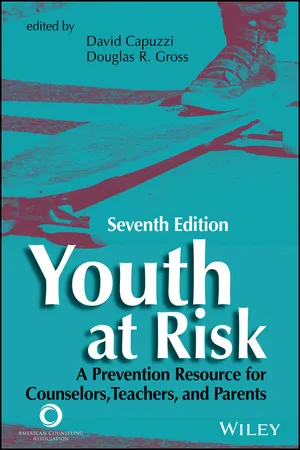
Youth at Risk
A Prevention Resource for Counselors, Teachers, and Parents
- English
- ePUB (mobile friendly)
- Available on iOS & Android
Youth at Risk
A Prevention Resource for Counselors, Teachers, and Parents
About this book
This comprehensive text, written by experts in each topical area, provides research-based approaches designed for work with youth in the difficult transition from adolescence to adulthood. Developmental in its orientation, the text moves from population definition and identification, to causal factors and issues most often identified with placing youth at risk, to a prevention–intervention paradigm specifically created for teens. Illustrative case studies and enlightening sidebars enhance reader self-awareness, promote self-study and skill development, and aid in the comprehension of the concepts and applications of chapter material. Complimentary PowerPoint slides, test banks, and instructional activities are available for instructors' use by request to ACA.
*Requests for digital versions from ACA can be found on www.wiley.com
*To purchase print copies, please visit the ACA website
*Reproduction requests for material from books published by ACA should be directed to [email protected]
Frequently asked questions
- Essential is ideal for learners and professionals who enjoy exploring a wide range of subjects. Access the Essential Library with 800,000+ trusted titles and best-sellers across business, personal growth, and the humanities. Includes unlimited reading time and Standard Read Aloud voice.
- Complete: Perfect for advanced learners and researchers needing full, unrestricted access. Unlock 1.4M+ books across hundreds of subjects, including academic and specialized titles. The Complete Plan also includes advanced features like Premium Read Aloud and Research Assistant.
Please note we cannot support devices running on iOS 13 and Android 7 or earlier. Learn more about using the app.
Information

PART I
Introducing the Problem

Chapter 1
Defining Youth at Risk
As John Patron sat down at the large table in the conference room, he hoped that something positive could come from this meeting—perhaps something finally could be done to help some of the students in his classroom. He knew that he had been instrumental in forcing Ms. Callis, his principal, to call this meeting. He hoped that all of his colleagues attending the meeting shared his view on the urgency of taking some positive action.This was John’s third year of teaching, and each day he was confronted with problems in his classroom. The problems were not those of math, his subject area, but problems that he observed and that were reported to him by many of his students. The problems covered a wide range of areas, including pregnancy, gangs, drugs and alcohol, violence, eating disorders, and dropping out of school. Certainly he was not the first to notice these problems or the only teacher in whom students confided. If these problems were so obvious to him, why hadn’t something been done to deal with them? Most of his students were now juniors in high school, and he was sure that the problems did not have their origins in attaining junior status.He did the best he could, but he was not trained to handle these issues. In seeking direction, he talked with the school counselor, the school psychologist, and Ms. Callis. Although all of the people he contacted wanted to help, they were also overwhelmed by the demands on their time. John’s questions for the most part went unanswered. If he was correct that these problems had not begun during the students’ junior year in high school, why hadn’t something been done earlier? Hadn’t former school personnel recognized the difficulties these students were having? Hadn’t parents asked for help with their children? Why hadn’t something been done to prevent these problems from developing? John hoped that answers would be forthcoming at the meeting.After the meeting John sat in his classroom and reflected on what had happened. He was very pleased that he was not alone in his concern about the students and that his colleagues had raised many of the same questions that plagued him. He was also pleased that many of his colleagues saw a need for adding trained personnel to work with teachers, students, and parents in developing strategies to intervene in the disrupted lives of many of the students before it was too late. John felt that several helpful outcomes had resulted from the meeting. The first of these was exploring the development of prevention strategies aimed at early identification of problem behaviors and establishing programs directed at impeding their development. This outcome generated much discussion centering around such questions as “What constitutes prevention?” “How does prevention differ from crisis management?” “What have other schools tried, and what has worked?” “Do we need to go beyond the school to build a prevention program?” and “What part will the community and parents play in the prevention program?”The second outcome dealt with identifying other risk issues, such as low self-esteem, issues in the family, suicide, increased sexual activity, bullying, the impact of homelessness, and excessive dependence on social media. This outcome had led to a discussion of the questions “Are there community resources we can use to aid us in better dealing with these identified problems?” and “What do we need to do to effectively utilize these resources?”A third outcome dealt with the concept of resilience and the related questions “What makes some young people resilient to high-risk environments while others succumb to these same environments?” and “What are the characteristics of both the individual and his or her environment that make him or her resistant to these high risks?” John had not thought much about resilience and was excited about finding answers to these questions. He sensed that the questions had come more easily than the answers would.The major directives that came from the meeting were (a) the establishment of a committee to investigate what was currently being done by other schools to develop an approach to prevention, (b) the development of a list of community mental health services that could be utilized by the school to supplement the work currently being done by the school staff, and (c) the collection of data relating to the concept of resilience and how these data would affect the development of a prevention program. John had volunteered to serve as chairperson of the committee investigating current programs and to assist in gaining more information about the issue of resilience. He looked forward to the next meeting that was scheduled in 2 weeks.• • •
Sidebar 1.1 Taking a Stand on Crisis Management Versus Prevention
A Foundational Perspective
Table of contents
- Cover
- Title Page
- Copyright Page
- Table of Contents
- Preface
- Acknowledgments
- About the Editors
- About the Contributors
- PART I: Introducing the Problem
- PART II: Examining the Causes
- PART III: Working With Youth at Risk: Prevention and Intervention
- Index
- Technical Support